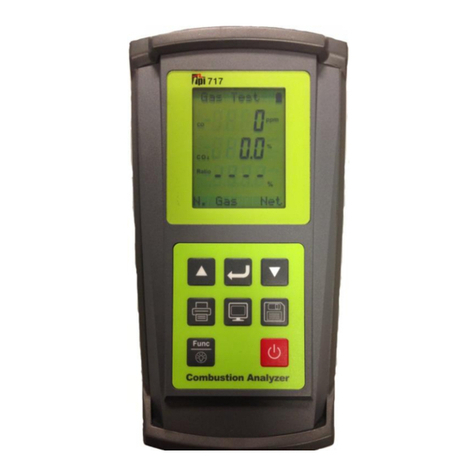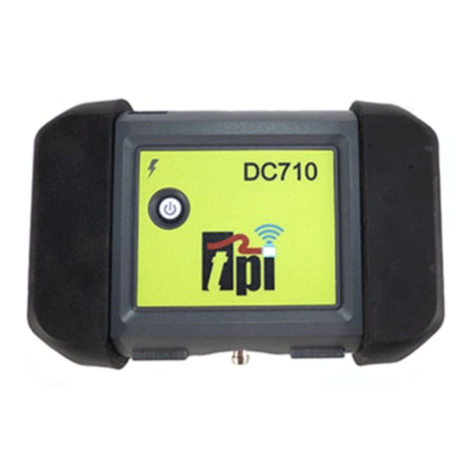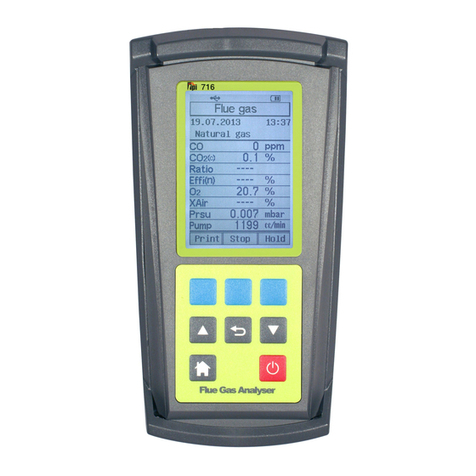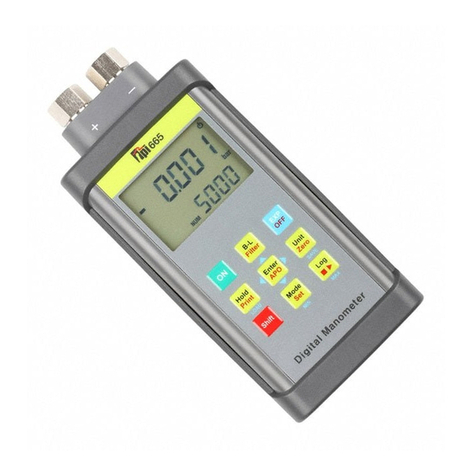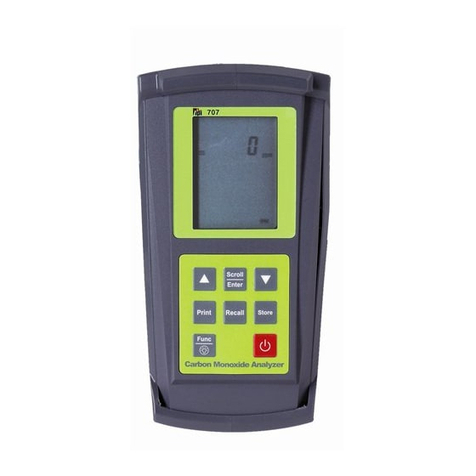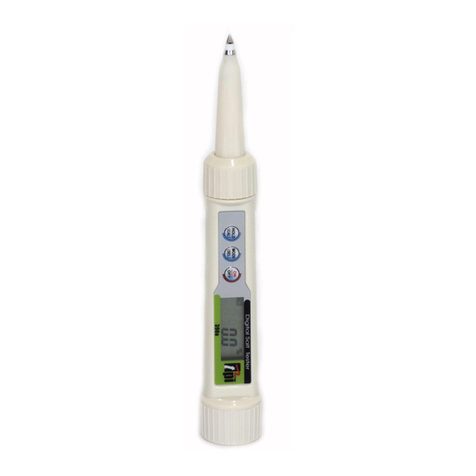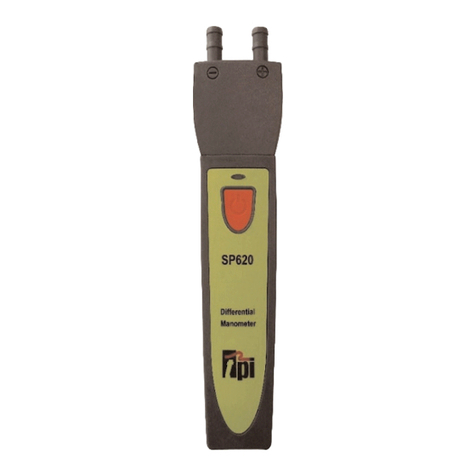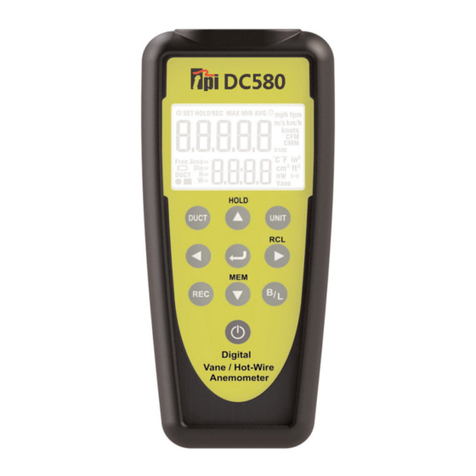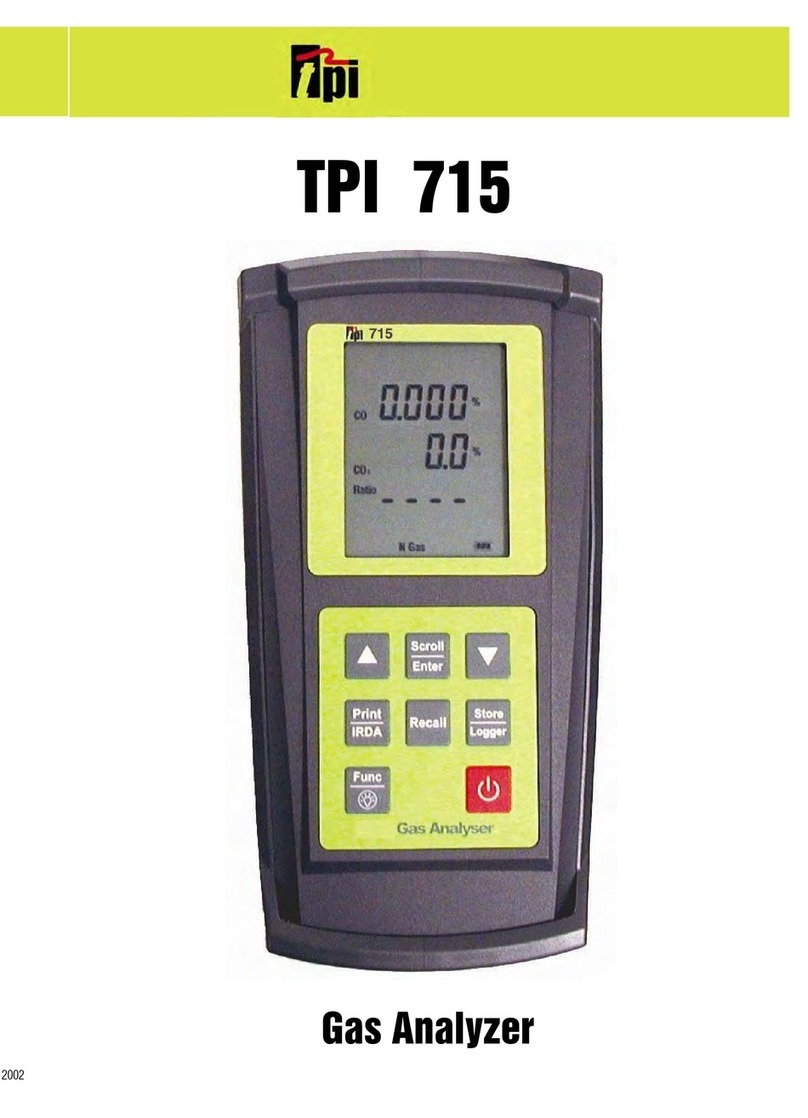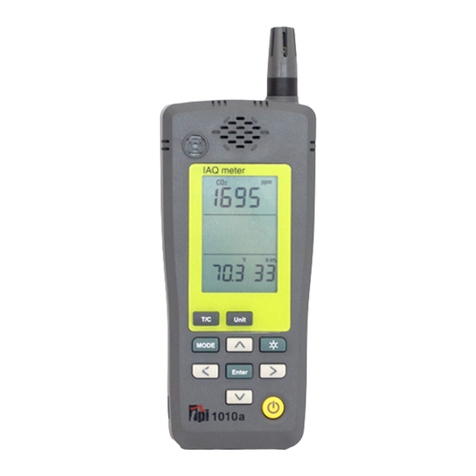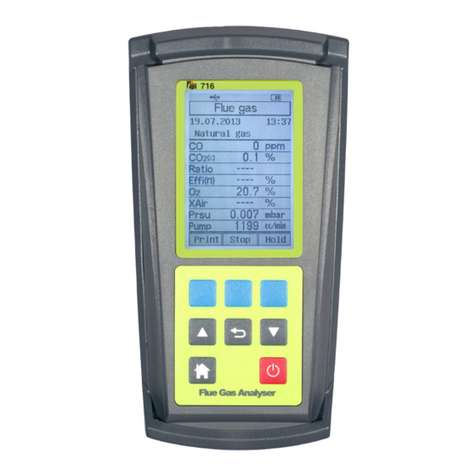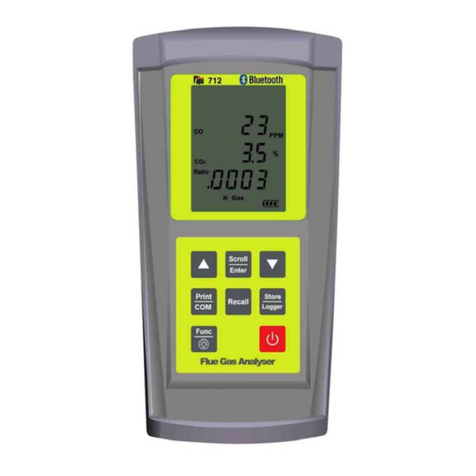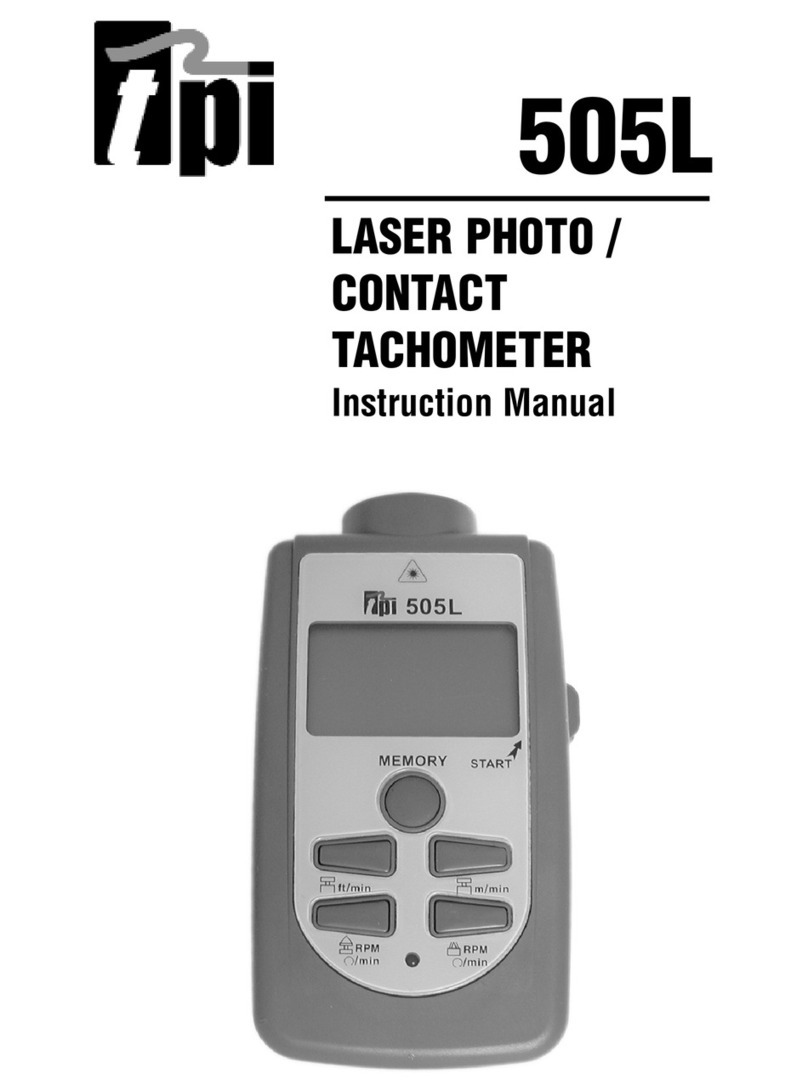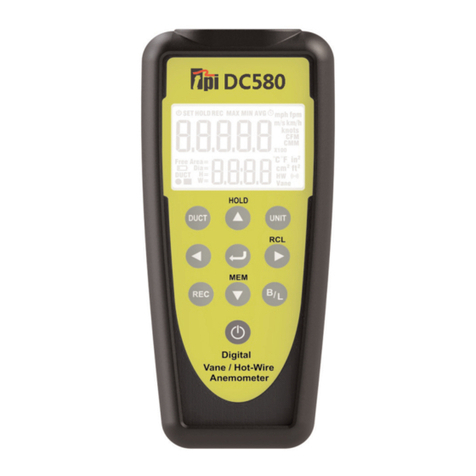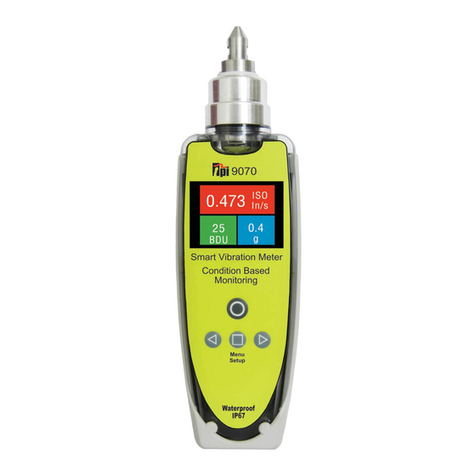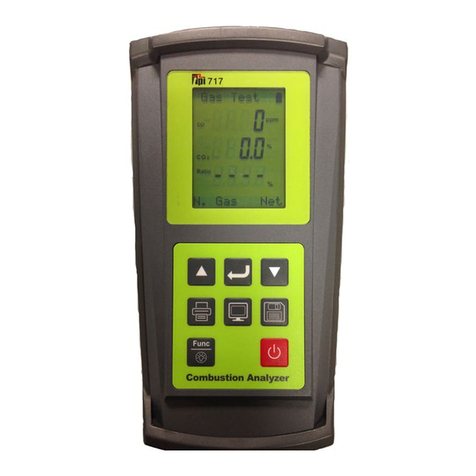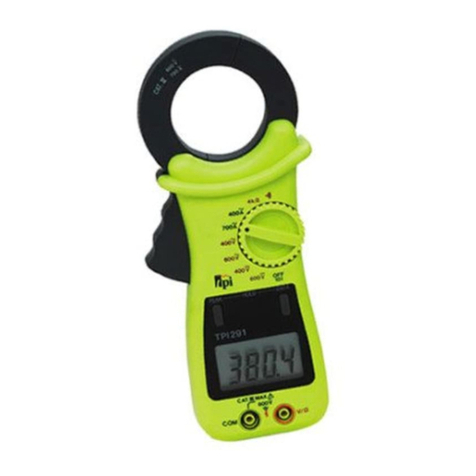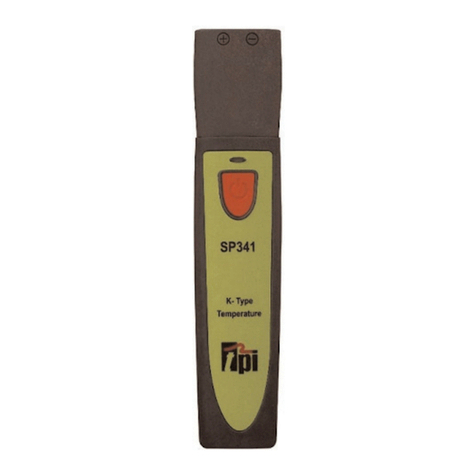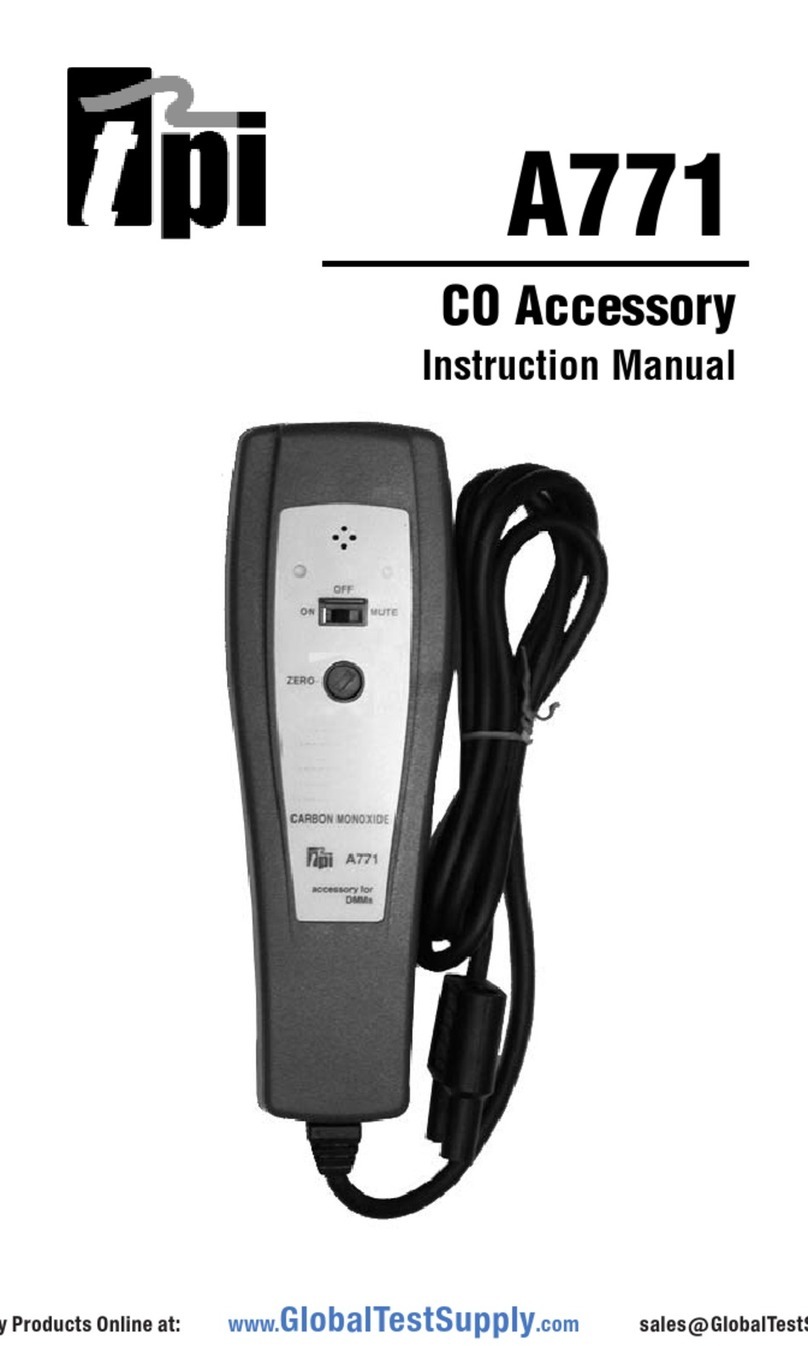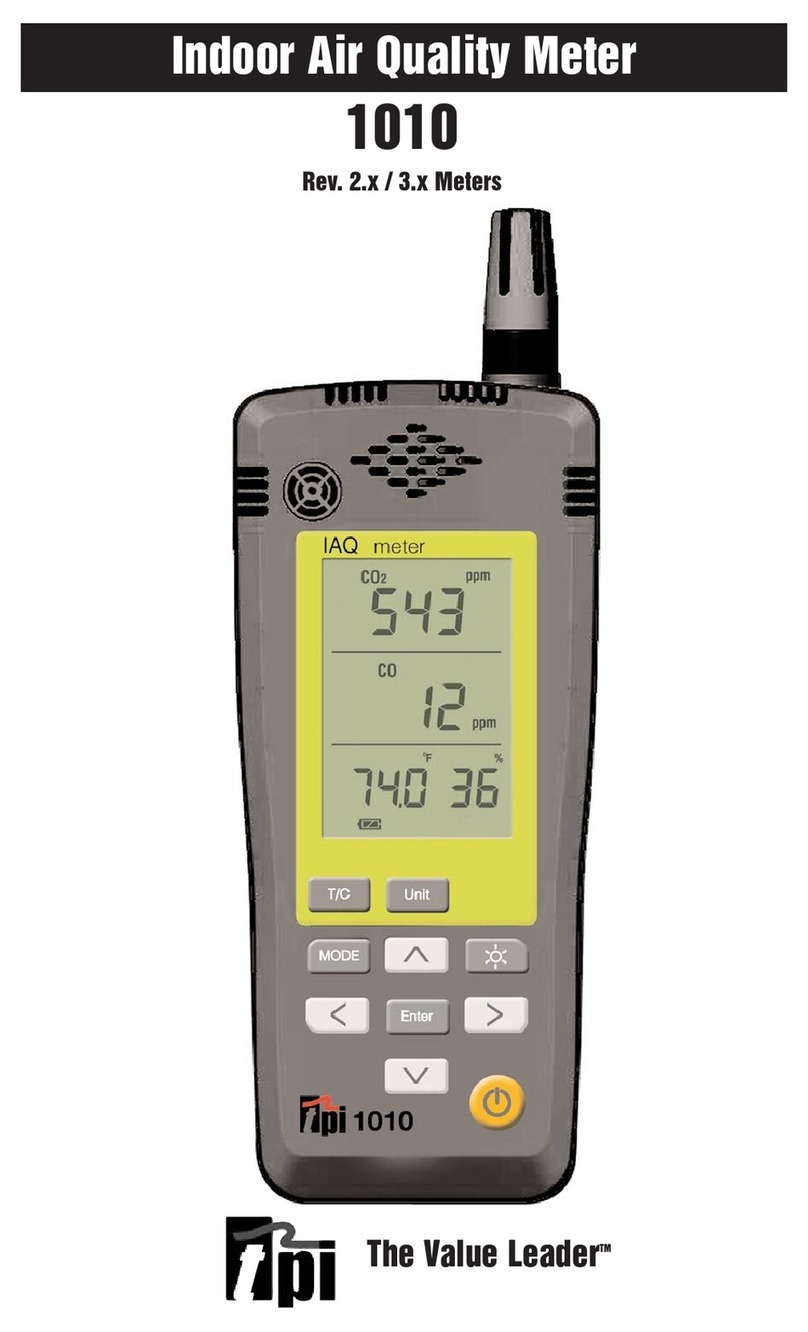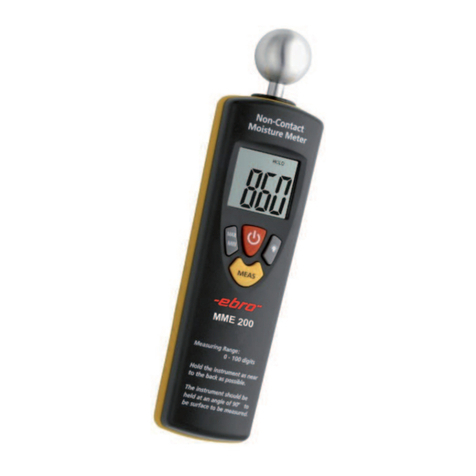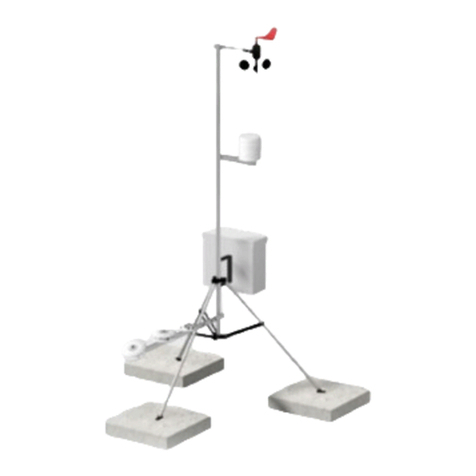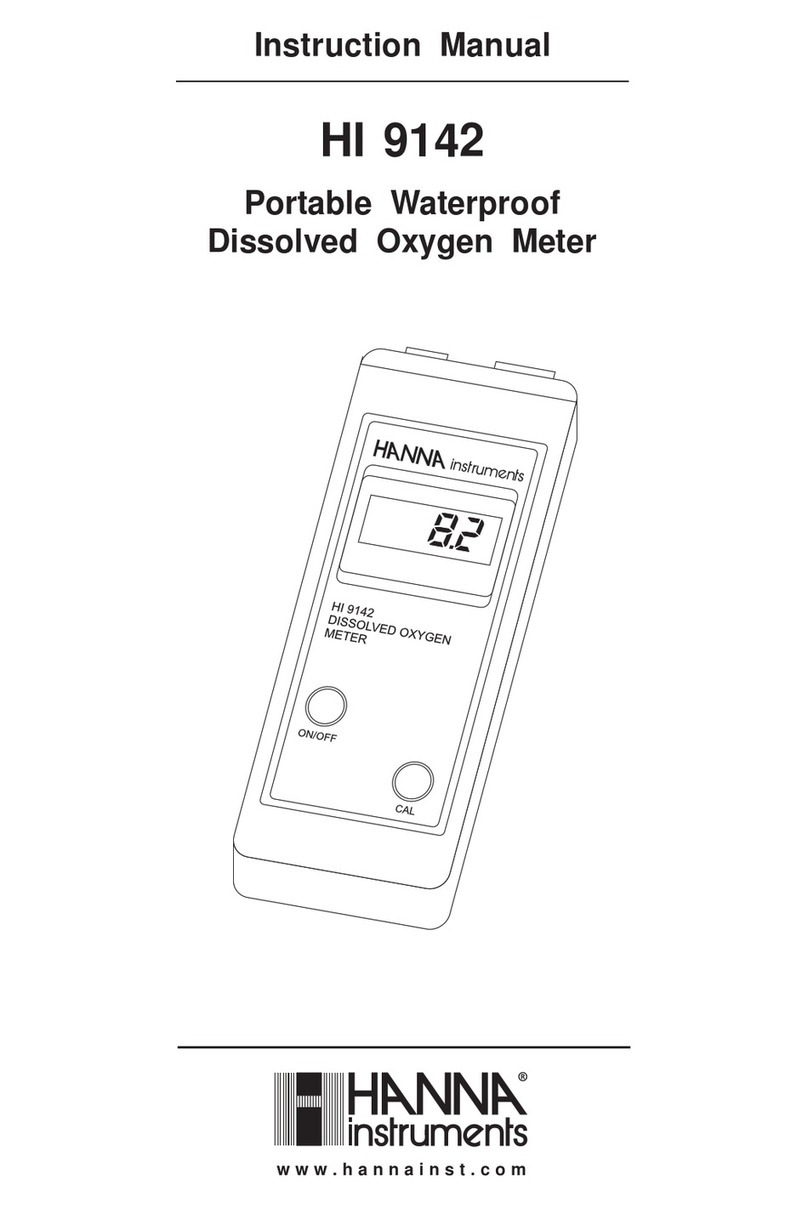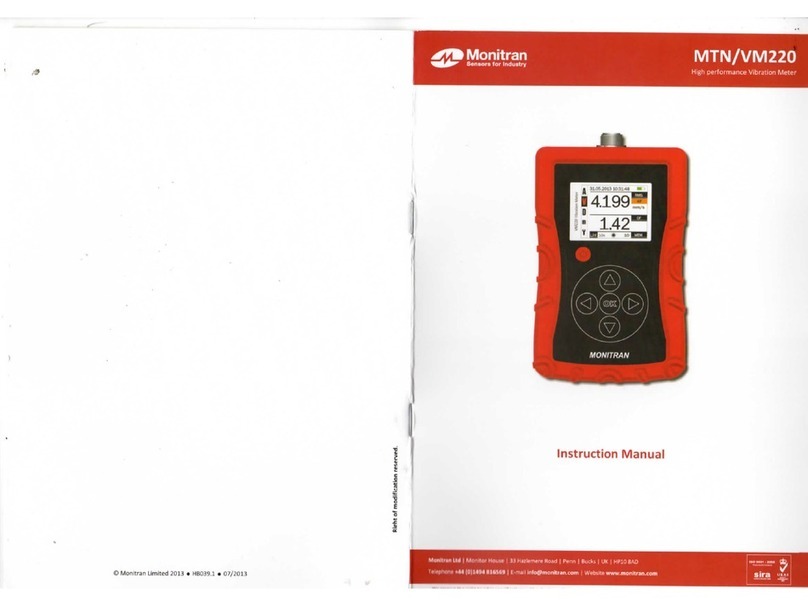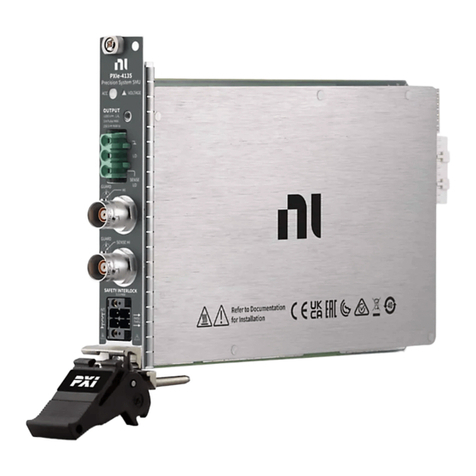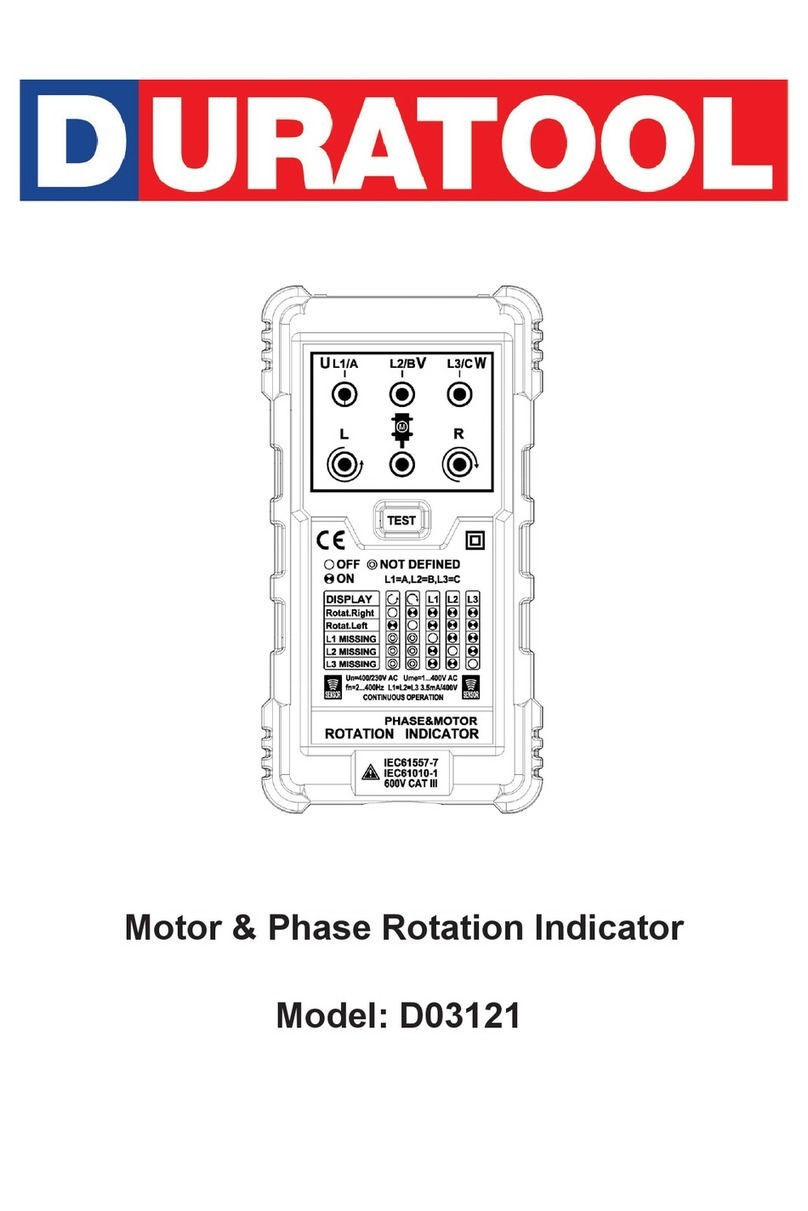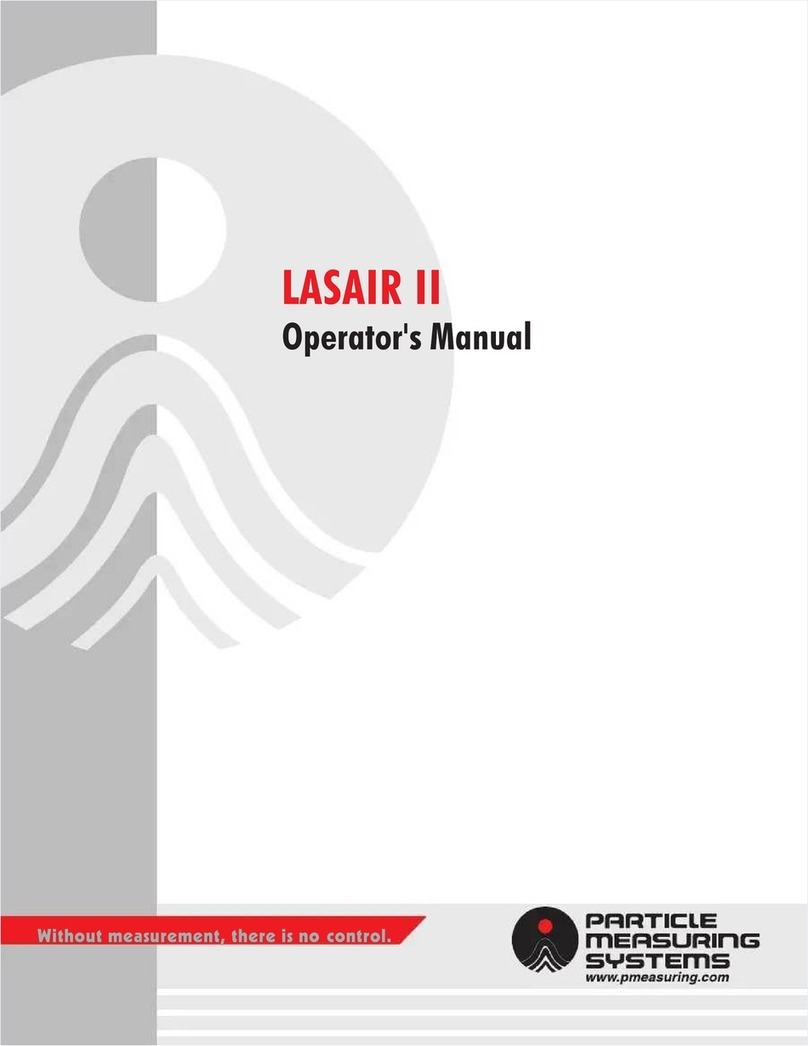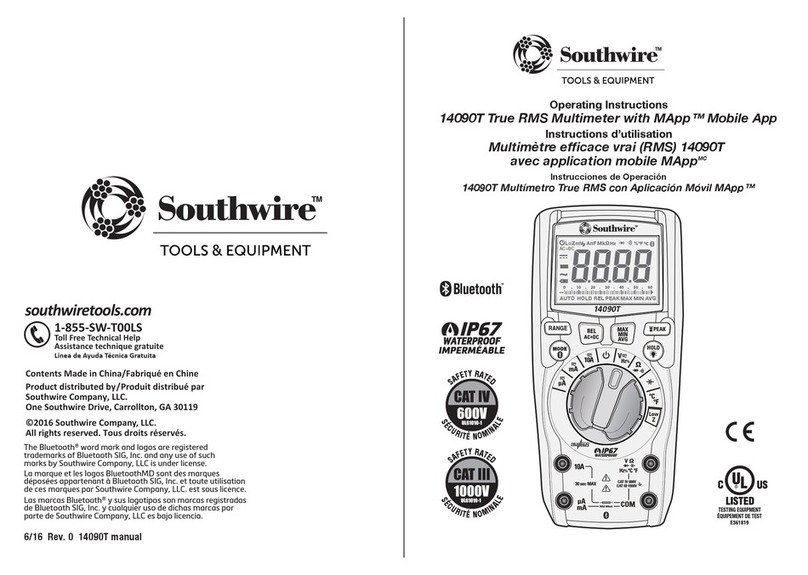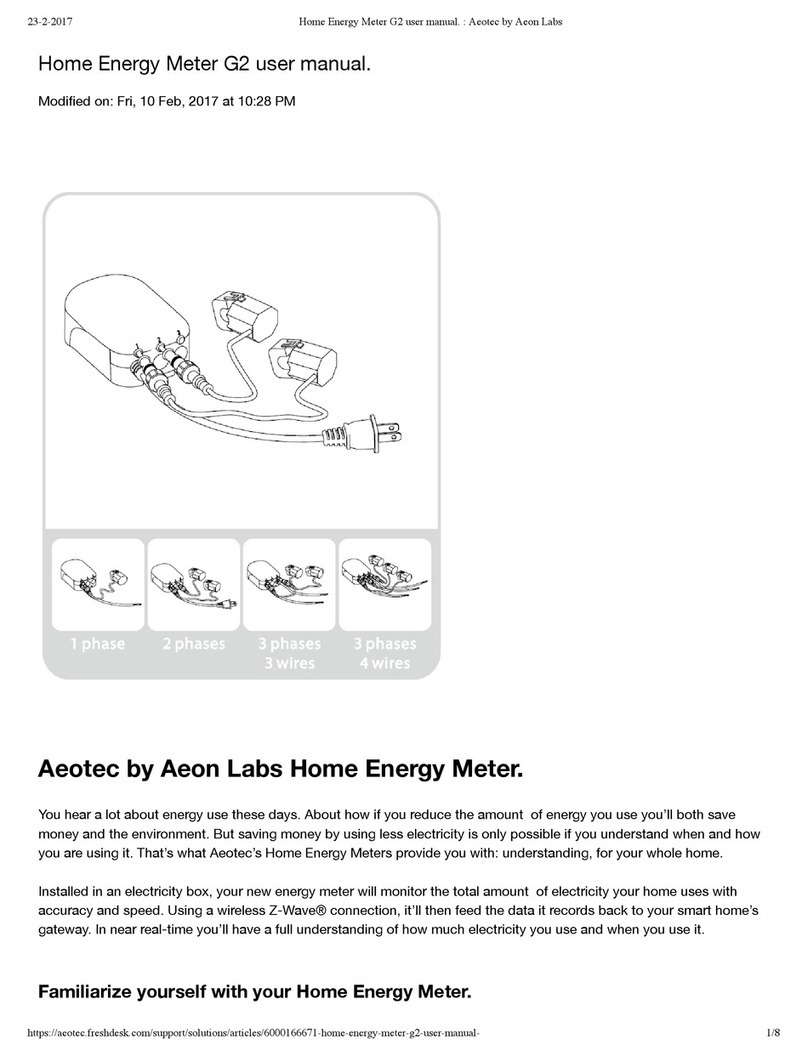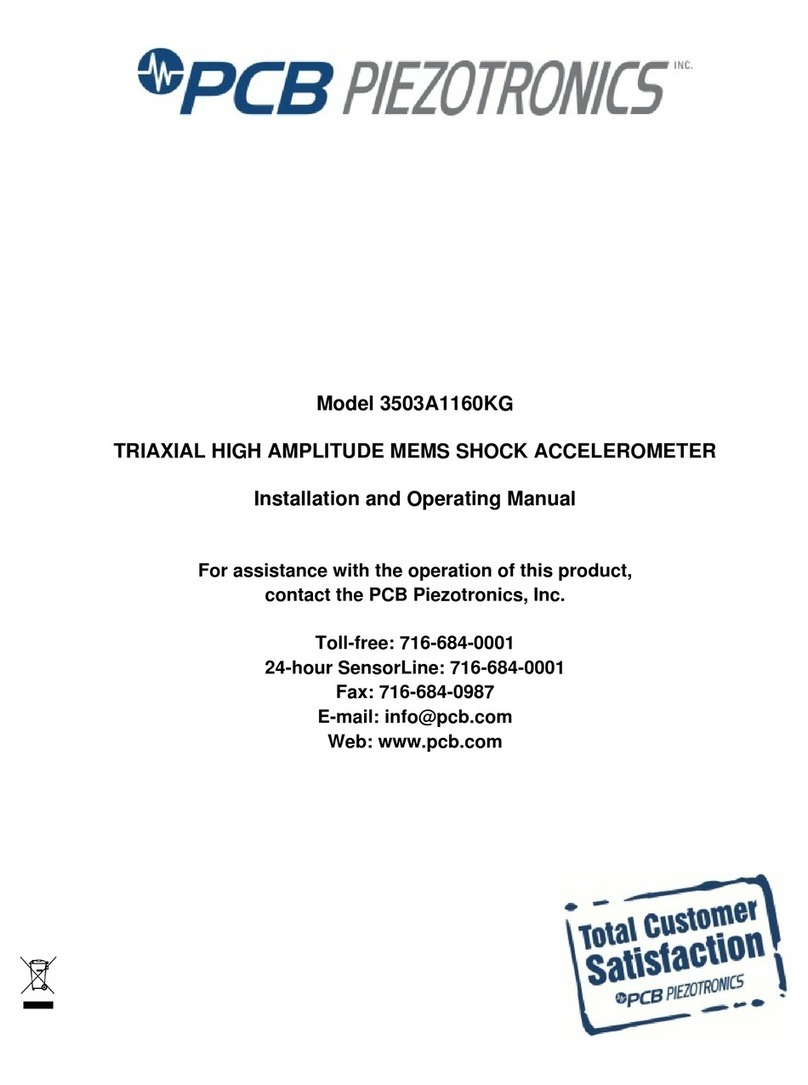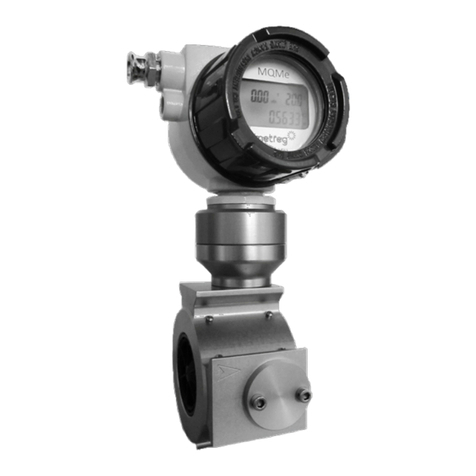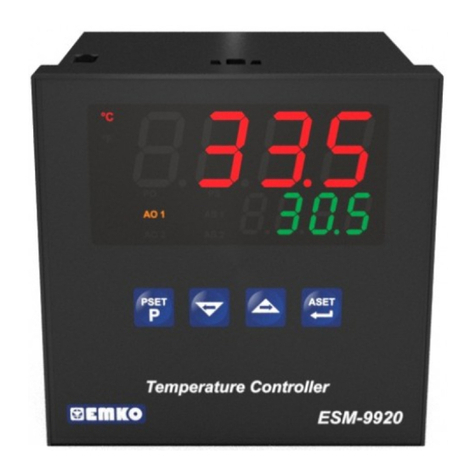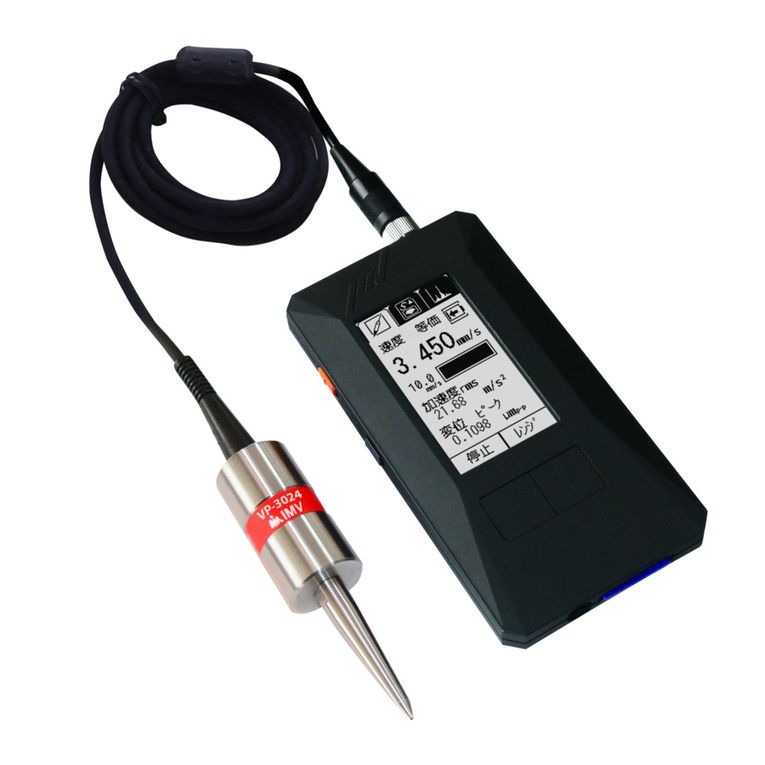TPI 714 User manual

714
Flue Gas Analyzer
The Value LeaderTM
www.tpi-thevalueleader.com

1. Introduction
Thank you for purchasing TPI brand products. The TPI 714 Flue Gas
Analyzer is a state of the art, easy to use analyzer designed not only to
display and calculate the required readings from a flue but also to
cover most of the other measurements associated with combustion.
The instrument is ruggedly constructed and comes with a 3 Year unit
and 2 Year sensor Guarantee.
2. General Overview
The TPI 714 combustion analyzer uses state of the art electrochemical
sensors. This sensor technology provides the longest lasting, most
accurate and reliable means for performing combustion tests. The sen-
sors in your analyzer will need to be replaced periodically and calibra-
tion is recommended once every year.
Electrochemical sensors by nature are always active. Therefore the
time the analyzer is off and not being used must be taken into account
when determining sensor life. The sensors in your analyzer are war-
ranted for two years. This warranty does not cover sensors damaged
through misuse of the analyzer.
You should keep the battery of your 714 charged so power is constant-
ly being supplied to your sensors.
The following guidelines will help prevent damage to your sensors:
Always use the mini pump filter when testing flue gases.
Always periodically check and replace the mini pump filter as needed.
Always make sure the in-line filter / water trap is installed properly.
Always periodically check and replace the in-line filter as needed.
Always remove water or condensation from the inside of the in-line fil-
ter / water trap assembly prior to performing tests.
Always use the optional oil filter (p/n A773) when performing tests on
oil burning equipment.
Contents
1. Introduction
2. General Overview
3. Instrument Overview
3.1 Front View
3.2 Back View
3.3 Side Views
3.4 Top View
4. Turning On & Off and Charging
4.1 Turning On
4.2 Turning Off
4.3 Charging
4.4 Activating The Backlight
5. Combustion Analysis
5.1 Overview
5.2 Procedure
5.3 Combustion Displays
5.4 Typical Test Locations
5.5 Typical Test Results
6. Function Selection
6.1 Function 1 - Thermometer
6.2 Function 2 - Manometer
6.3 Function 3 - Date / Time
6.4 Function 4 - Combustion Analysis
7. Saving Data
8. Recalling Data
9. Printing Data
10. Logging Data
11. Communicating to a PC
Appendix A Specifications
Appendix B Calibration & Service
Appendix C Guarantee
Appendix D Installing the Optional A773 Filter
Appendix E Error Codes and Trouble Shooting
Appendix F CO Alarm Settings
Appendix G Manually Initializing Sensors

1. Introduction
Thank you for purchasing TPI brand products. The TPI 714 Flue Gas
Analyzer is a state of the art, easy to use analyzer designed not only to
display and calculate the required readings from a flue but also to
cover most of the other measurements associated with combustion.
The instrument is ruggedly constructed and comes with a 3 Year unit
and 2 Year sensor Guarantee.
2. General Overview
The TPI 714 combustion analyzer uses state of the art electrochemical
sensors. This sensor technology provides the longest lasting, most
accurate and reliable means for performing combustion tests. The sen-
sors in your analyzer will need to be replaced periodically and calibra-
tion is recommended once every year.
Electrochemical sensors by nature are always active. Therefore the
time the analyzer is off and not being used must be taken into account
when determining sensor life. The sensors in your analyzer are war-
ranted for two years. This warranty does not cover sensors damaged
through misuse of the analyzer.
You should keep the battery of your 714 charged so power is constant-
ly being supplied to your sensors.
The following guidelines will help prevent damage to your sensors:
Always use the mini pump filter when testing flue gases.
Always periodically check and replace the mini pump filter as needed.
Always make sure the in-line filter / water trap is installed properly.
Always periodically check and replace the in-line filter as needed.
Always remove water or condensation from the inside of the in-line fil-
ter / water trap assembly prior to performing tests.
Always use the optional oil filter (p/n A773) when performing tests on
oil burning equipment.
Contents
1. Introduction
2. General Overview
3. Instrument Overview
3.1 Front View
3.2 Back View
3.3 Side Views
3.4 Top View
4. Turning On & Off and Charging
4.1 Turning On
4.2 Turning Off
4.3 Charging
4.4 Activating The Backlight
5. Combustion Analysis
5.1 Overview
5.2 Procedure
5.3 Combustion Displays
5.4 Typical Test Locations
5.5 Typical Test Results
6. Function Selection
6.1 Function 1 - Thermometer
6.2 Function 2 - Manometer
6.3 Function 3 - Date / Time
6.4 Function 4 - Combustion Analysis
7. Saving Data
8. Recalling Data
9. Printing Data
10. Logging Data
11. Communicating to a PC
Appendix A Specifications
Appendix B Calibration & Service
Appendix C Guarantee
Appendix D Installing the Optional A773 Filter
Appendix E Error Codes and Trouble Shooting
Appendix F CO Alarm Settings
Appendix G Manually Initializing Sensors

3. Instrument Overview
3.1 Front View
Rubber Boot Protects the instrument from accidental damage
Display Large 3 Parameter Backlit LCD Display
Battery Condition Icon Shows condition of rechargeable batteries.
Keypad Selects all available functions
Selected Fuel Type N GAS, LPG, LIGHT OIL, HEAVY OIL, OPT 1
(Bituminous Coal), OPT 2 (Anthracite Coal),
OPT 3 (Coke), OPT 4 (Butane), OPT 5 (Wood),
OPT 6 (Bagasse)
Rubber
Boot
LCD
Display
Keypad
Battery
Condition
Icon
Selected
Fuel Type
General Overview (Continued)
Never over saturate your sensors by performing tests on equipment with
gas levels beyond the capability of you analyzer.
Always keep the A762 water trap / filter assembly clean and replace the fil-
ter as necessary. Replacement filter part number is A762F.
This manual will guide you through the functions of the TPI 714 which will
give you many years of reliable service.
Your TPI 714 Flue Gas Analyzer comes complete with the following stan-
dard accessories:
• TPI 714 Instrument
• Rubber Boot (A765)
• Infrared Printer (A740) (model 714A740 comes with the printer)
• Soft Carrying Case (A768)
• Flue Sampling Probe (A770)
• In-Line Filter installed on Flue probe (A762)
• Spare In-Line Filter (one included) (A762F is a package of 5 filters)
• Temperature Probe (GK11M)
• Battery Charger (A766)
• Mini Pump Protection Filter Assembly and spare filters (A763)
• Exhaust Spigot (removable) (A764)
• Pressure Tubing (A774)
• Static Pressure Tips (A776)x2
• Barbed to 1/8” NPT fittings (2 each)
• Gas Valve Adapter (A611)
• Adapter Tubing (
• Instruction Manual
( ) Denotes part number
Your TPI 714 Flue Gas Analyzer has the following options available:
• PC Software for analysis of Data Logging results (see 11 &
Appendix B)
• Infrared PC link for non compatible PCs (see 11 & Appendix B)
• Various Temperature Probes (see Appendix B)

3. Instrument Overview
3.1 Front View
Rubber Boot Protects the instrument from accidental damage
Display Large 3 Parameter Backlit LCD Display
Battery Condition Icon Shows condition of rechargeable batteries.
Keypad Selects all available functions
Selected Fuel Type N GAS, LPG, LIGHT OIL, HEAVY OIL, OPT 1
(Bituminous Coal), OPT 2 (Anthracite Coal),
OPT 3 (Coke), OPT 4 (Butane), OPT 5 (Wood),
OPT 6 (Bagasse)
Rubber
Boot
LCD
Display
Keypad
Battery
Condition
Icon
Selected
Fuel Type
General Overview (Continued)
Never over saturate your sensors by performing tests on equipment with
gas levels beyond the capability of you analyzer.
Always keep the A762 water trap / filter assembly clean and replace the fil-
ter as necessary. Replacement filter part number is A762F.
This manual will guide you through the functions of the TPI 714 which will
give you many years of reliable service.
Your TPI 714 Flue Gas Analyzer comes complete with the following stan-
dard accessories:
• TPI 714 Instrument
• Rubber Boot (A765)
• Infrared Printer (A740) (model 714A740 comes with the printer)
• Soft Carrying Case (A768)
• Flue Sampling Probe (A770)
• In-Line Filter installed on Flue probe (A762)
• Spare In-Line Filter (one included) (A762F is a package of 5 filters)
• Temperature Probe (GK11M)
• Battery Charger (A766)
• Mini Pump Protection Filter Assembly and spare filters (A763)
• Exhaust Spigot (removable) (A764)
• Pressure Tubing (A774)
• Static Pressure Tips (A776)x2
• Barbed to 1/8” NPT fittings (2 each)
• Gas Valve Adapter (A611)
• Adapter Tubing (
• Instruction Manual
( ) Denotes part number
Your TPI 714 Flue Gas Analyzer has the following options available:
• PC Software for analysis of Data Logging results (see 11 &
Appendix B)
• Infrared PC link for non compatible PCs (see 11 & Appendix B)
• Various Temperature Probes (see Appendix B)

3.2 Back View
Sample and Pressure Inlet Ports: Connection for Gas Sampling Probe (see
3.4 & 5.2)
Connection for Mini Pump
Protection Filter (see 3.4 & 6.2)
Connections for Pressure Tubing: (see 3.4 & 6.2)
Calibration and Information Label: Displays calibration information and
Displays serial number
Battery Compartment: Holds rechargeable battery
Rubber Boot Protects the instrument
Calibration and
Information
Label
Battery
Compartment
Rubber
Boot
Connection for
Mini Pump
Protection Filter
Connections for
Pressure Tubing
Sample and
Pressure Inlet
Ports
Scrolls through selectable fuels (see 3.1 & 4.1)
Switches between Gross and Net Efficiency (see 5.3)
Switches between ºC and ºF (see 5.3 & 6.1)
Moves up through the Stored Data Addresses (see 7, 8, 9)
Increases data logging time intervals (see 10)
Zeroes pressure reading (see 6.2)
Moves down through the Stored Data Addresses (see 7, 8, 9)
Decreases data logging time intervals (see 10)
Scrolls through Combustion Analysis Displays (See 5.3)
Scrolls through Function Screens (see 6)
Turns temperature differential calculation ON/OFF (see 6.1)
Turns ch2 temperature ON/OFF (see 6.2)
Allows you to change the Date and Time (see 6.3)
Allows you to choose a Stored Data Address (see 7, 8, 9, 10)
Sends stored data to a separate infrared printer (see 9)
or IRDA adapter (p/n A767) (See 11)
Allows you to view stored data on the display (see 8)
Stores readings to memory (see 7)
Starts and Stops data logging (see 10)
Scrolls through and selects analyzer functions (see 6)
Turns Backlight ON and OFF (see 4.4)
Turns the instrument ON and OFF (see 4.1 & 4.2)
Print
COM
Recall
Store
Logger
Func
Scroll
Enter

3.2 Back View
Sample and Pressure Inlet Ports: Connection for Gas Sampling Probe (see
3.4 & 5.2)
Connection for Mini Pump
Protection Filter (see 3.4 & 6.2)
Connections for Pressure Tubing: (see 3.4 & 6.2)
Calibration and Information Label: Displays calibration information and
Displays serial number
Battery Compartment: Holds rechargeable battery
Rubber Boot Protects the instrument
Calibration and
Information
Label
Battery
Compartment
Rubber
Boot
Connection for
Mini Pump
Protection Filter
Connections for
Pressure Tubing
Sample and
Pressure Inlet
Ports
Scrolls through selectable fuels (see 3.1 & 4.1)
Switches between Gross and Net Efficiency (see 5.3)
Switches between ºC and ºF (see 5.3 & 6.1)
Moves up through the Stored Data Addresses (see 7, 8, 9)
Increases data logging time intervals (see 10)
Zeroes pressure reading (see 6.2)
Moves down through the Stored Data Addresses (see 7, 8, 9)
Decreases data logging time intervals (see 10)
Scrolls through Combustion Analysis Displays (See 5.3)
Scrolls through Function Screens (see 6)
Turns temperature differential calculation ON/OFF (see 6.1)
Turns ch2 temperature ON/OFF (see 6.2)
Allows you to change the Date and Time (see 6.3)
Allows you to choose a Stored Data Address (see 7, 8, 9, 10)
Sends stored data to a separate infrared printer (see 9)
or IRDA adapter (p/n A767) (See 11)
Allows you to view stored data on the display (see 8)
Stores readings to memory (see 7)
Starts and Stops data logging (see 10)
Scrolls through and selects analyzer functions (see 6)
Turns Backlight ON and OFF (see 4.4)
Turns the instrument ON and OFF (see 4.1 & 4.2)
Print
COM
Recall
Store
Logger
Func
Scroll
Enter

3.3 Side Views
Exhaust Port Port for connection of Exhaust Adapter
Infrared Window Window for sending stored data to IR Printer or
PC (see 9 & 11)
Rubber Boot Protects the instrument from accidental damage
Exhaust
Port
Infrared
Window
Rubber
Boot
Charger
Socket
T1
T2
P (+) P (-)
Gas Sampling Port
Charger Socket Connection for 220V/115V charger (see 4.3)
T1 Socket Connection for thermocouple plug on flue probe
(see 5.2)
Connection for any 'K' type thermocouple probe
(see 6.1)
T2 Socket Connection for any 'K' type thermocouple probe
(see 5.2 & 6.1)
Gas Sample Port Connection for Gas Sampling Probe (see 5.2)
P (+) Port Connections for Pressure Tubing (see 6.2)
P (-) Port Connections for Pressure Tubing (see 6.2)
3.4 Top View

3.3 Side Views
Exhaust Port Port for connection of Exhaust Adapter
Infrared Window Window for sending stored data to IR Printer or
PC (see 9 & 11)
Rubber Boot Protects the instrument from accidental damage
Exhaust
Port
Infrared
Window
Rubber
Boot
Charger
Socket
T1
T2
P (+) P (-)
Gas Sampling Port
Charger Socket Connection for 220V/115V charger (see 4.3)
T1 Socket Connection for thermocouple plug on flue probe
(see 5.2)
Connection for any 'K' type thermocouple probe
(see 6.1)
T2 Socket Connection for any 'K' type thermocouple probe
(see 5.2 & 6.1)
Gas Sample Port Connection for Gas Sampling Probe (see 5.2)
P (+) Port Connections for Pressure Tubing (see 6.2)
P (-) Port Connections for Pressure Tubing (see 6.2)
3.4 Top View

4. Turning On & Off and Charging
4.1 Turning On
Always: - Before turning on please ensure that the Mini Pump Protection Filter
assembly and the Temperature Sampling Probe complete with In-Line Filter or the
Tubing & In-Line Filter for Leak Detection are not connected to the Gas Sample
Port (see 2.2 or 2.4)
Press and hold down the Power Key and the TPI 714 will start its 30 second
countdown 'PURGE' will be displayed: - The instrument MUST be turned on in a
clean air environment as the 30 second purge will set the Carbon Monoxide level
to Zero and the Oxygen to 20.9%. The 714 may re-start the coutdown several
times before normal operation. This means the sensors are still initializing
and is normal.
Ensure that the filters are clean and dry as dirty or wet filters will result in a loss
of flow rate and 'Lo Flo' will be displayed to inform you that filters should be
changed
During the last 20 seconds of the 30 second purge time the user can scroll
through the following Fuels: - Natural Gas, LPG, Light Oil, Heavy Oil, OPT1 :
Bituminous Coal, OPT 2 : Anthracite Coal, OPT 3: Coke, OPT 4: Butane, OPT 5:
Wood (Dry), OPT 6: Bagasse by pressing the Up Arrow Key to select the Fuel
they are working with. When desired fuel is displayed release the key, displayed
fuel is now selected.
After the 30 second countdown the instrument is ready to take Flue, Temperature,
Pressure or Leak Detection readings and Combustion Display 1 will be the first
display.
The 714 will auto power off if no keys have been pressed for 10 minutes and the
CO level is below 15ppm.
The Scroll/Enter Key allows you to scroll through the combustion displays as out-
lined in section 5.3. The Func Key is used to select the 714 function mode and
allows you to set it to be a combustion analyzer, manometer, thermometer, or
combustible leak detector. In addition, the Func Key is used to access the date
and time display. See section 6 for more information on the Func Key.
4.2 Turning Off
Always: - Before turning off return the instrument to a clean air environment and
allow the Carbon Monoxide level to return to below 15ppm and the Oxygen level
to return to 20.9% (± 0.3%) Press the Power Key to turn the instrument off:-
NOTE Should you attempt to turn the instrument Off and the CO reading is above
15ppm then the instrument will remain On and a short Beep will be heard. The
Instrument can only be switched off if the CO is below 15ppm
The instrument has an auto shut off after 10 minutes should no keys have been
pressed for this period and as mentioned above that the CO is below 15ppm.
Should the CO be above 15ppm then the 10 minute auto shut off countdown will
not begin till the CO has gone below 15ppm
4.3 Charging
Plug the Charger supplied into the charger socket on the instrument (see 3.4). If
the instrument is turned on then a charging symbol will be displayed. Should the
instrument then be turned off, turn off automatically or be turned off when the
charger is plugged in then the charging symbol will not be displayed BUT the
instrument will still be charging.
The instrument should be charged overnight for a period of 10 to 12 hours and
will give over 6 hours Operating Time. If a beeping noise is heard during charging
disconnect the charger. This is an indication of something wrong in the charging
circuit. Please contact TPI technical assistance at 800-368-5719.
Alternatively, the instrument can be used when plugged into the charger.
4.4 Activating the Backlight
The display backlight can be activated at any time by pressing and holding down
the Func Key for approximately 2 seconds. The backlight will automatically shut
off after approximately 20 seconds to preserve battery life.
NOTE: When selecting oil as fuel be sure to use the optional
oil filter (A773) or readings could become erratic. See
Appendix E for installation instructions.

4. Turning On & Off and Charging
4.1 Turning On
Always: - Before turning on please ensure that the Mini Pump Protection Filter
assembly and the Temperature Sampling Probe complete with In-Line Filter or the
Tubing & In-Line Filter for Leak Detection are not connected to the Gas Sample
Port (see 2.2 or 2.4)
Press and hold down the Power Key and the TPI 714 will start its 30 second
countdown 'PURGE' will be displayed: - The instrument MUST be turned on in a
clean air environment as the 30 second purge will set the Carbon Monoxide level
to Zero and the Oxygen to 20.9%. The 714 may re-start the coutdown several
times before normal operation. This means the sensors are still initializing
and is normal.
Ensure that the filters are clean and dry as dirty or wet filters will result in a loss
of flow rate and 'Lo Flo' will be displayed to inform you that filters should be
changed
During the last 20 seconds of the 30 second purge time the user can scroll
through the following Fuels: - Natural Gas, LPG, Light Oil, Heavy Oil, OPT1 :
Bituminous Coal, OPT 2 : Anthracite Coal, OPT 3: Coke, OPT 4: Butane, OPT 5:
Wood (Dry), OPT 6: Bagasse by pressing the Up Arrow Key to select the Fuel
they are working with. When desired fuel is displayed release the key, displayed
fuel is now selected.
After the 30 second countdown the instrument is ready to take Flue, Temperature,
Pressure or Leak Detection readings and Combustion Display 1 will be the first
display.
The 714 will auto power off if no keys have been pressed for 10 minutes and the
CO level is below 15ppm.
The Scroll/Enter Key allows you to scroll through the combustion displays as out-
lined in section 5.3. The Func Key is used to select the 714 function mode and
allows you to set it to be a combustion analyzer, manometer, thermometer, or
combustible leak detector. In addition, the Func Key is used to access the date
and time display. See section 6 for more information on the Func Key.
4.2 Turning Off
Always: - Before turning off return the instrument to a clean air environment and
allow the Carbon Monoxide level to return to below 15ppm and the Oxygen level
to return to 20.9% (± 0.3%) Press the Power Key to turn the instrument off:-
NOTE Should you attempt to turn the instrument Off and the CO reading is above
15ppm then the instrument will remain On and a short Beep will be heard. The
Instrument can only be switched off if the CO is below 15ppm
The instrument has an auto shut off after 10 minutes should no keys have been
pressed for this period and as mentioned above that the CO is below 15ppm.
Should the CO be above 15ppm then the 10 minute auto shut off countdown will
not begin till the CO has gone below 15ppm
4.3 Charging
Plug the Charger supplied into the charger socket on the instrument (see 3.4). If
the instrument is turned on then a charging symbol will be displayed. Should the
instrument then be turned off, turn off automatically or be turned off when the
charger is plugged in then the charging symbol will not be displayed BUT the
instrument will still be charging.
The instrument should be charged overnight for a period of 10 to 12 hours and
will give over 6 hours Operating Time. If a beeping noise is heard during charging
disconnect the charger. This is an indication of something wrong in the charging
circuit. Please contact TPI technical assistance at 800-368-5719.
Alternatively, the instrument can be used when plugged into the charger.
4.4 Activating the Backlight
The display backlight can be activated at any time by pressing and holding down
the Func Key for approximately 2 seconds. The backlight will automatically shut
off after approximately 20 seconds to preserve battery life.
NOTE: When selecting oil as fuel be sure to use the optional
oil filter (A773) or readings could become erratic. See
Appendix E for installation instructions.

COMBUSTION ANALYSIS (Continued)
5.2 Procedure
1. Turn the 714 on as outlined in section 4.1. At any time you can activate the
Backlight by holding down the Func/Backlight Key for 2 seconds. The back-
light will automatically shut off after 20 seconds to preserve battery life.
2. Ensure you have connected the Mini Pump Protection Filter assembly and
Temperature Sampling Probe complete with In-Line Filter to the Gas Sample
Port (see 3.2 or 3.4) and the 'K' Type Thermocouple Plug into Thermocouple
(T1) Socket (see 3.4). The GK11M ambient air temperature probe must be
connected to the (T2) socket. (refer to figure below for correct hookup)
WARNING: - Ensure that the In-Line Filter hangs in a vertical position when
readings are being taken, particularly if water is visible. Failure to comply may
result in damage to the instrument.
WARNING: - There is ONLY one correct way to connect the 'K' type thermo-
couple plug into the socket (see 2.4). Forcing the plug into the socket the
wrong way round may result in damage to the instrument.
3. Insert the flue probe into the test location of the device under test. The
probe tip should be in the middle of the flue pipe or exhaust stream. Refer to
figures 1 through 3 for typical test locations.
Mini Pump
Protection Filter
Assembly
Ambient Air
Connection (T2)
GK11M Probe
Flue Probe
Connection (T1)
In-line Filter
Assembly
Flue Probe
Tubing
5. COMBUSTION ANALYSIS
5.1 Overview
Testing for carbon monoxide, oxygen, and stack temperature is very important to
the overall safety and efficiency of heating equipment. The following guidelines
and descriptions are generic and meant to provide you with a basic understand-
ing of combustion testing. TPI always recommends you contact the manufacturer
of the device under test, obtain information specific to the device, and follow the
procedures and safety guidelines for performing tests and affecting repairs.
In general, for most applications flue gas samples should be taken prior to the
draft diverter or any other opening that allows room air to enter the system. This
prevents room air from mixing with gases in the flue and diluting the test sample.
To ensure accurate and consistent combustion tests, it is important gas and tem-
perature samples be taken at the same location. This is easy with the TPI flue
probe because the temperature sensor is an integral part of the probe.
Prior to taking a sample, the device under test should be on and operating.
Putting the flue probe in the sample area prior to starting the device may cause
saturation of the sensors due to the higher initial concentration of carbon monox-
ide that may be encountered upon start up. If this happens, allow your analyzer to
purge in fresh air until the carbon monoxide level returns to 0 ppm and the oxy-
gen level returns to 20.9%. This may take more than an hour depending on how
saturated the sensors are.
The included figures show locations for performing tests on commonly encoun-
tered equipment. Remember to consult with the manufacturer of the device under
test for specific test information.
NOTE: When selecting oil as fuel be sure to use the optional
oil filter (A773) or readings could become erratic. See
Appendix E for installation instructions.

COMBUSTION ANALYSIS (Continued)
5.2 Procedure
1. Turn the 714 on as outlined in section 4.1. At any time you can activate the
Backlight by holding down the Func/Backlight Key for 2 seconds. The back-
light will automatically shut off after 20 seconds to preserve battery life.
2. Ensure you have connected the Mini Pump Protection Filter assembly and
Temperature Sampling Probe complete with In-Line Filter to the Gas Sample
Port (see 3.2 or 3.4) and the 'K' Type Thermocouple Plug into Thermocouple
(T1) Socket (see 3.4). The GK11M ambient air temperature probe must be
connected to the (T2) socket. (refer to figure below for correct hookup)
WARNING: - Ensure that the In-Line Filter hangs in a vertical position when
readings are being taken, particularly if water is visible. Failure to comply may
result in damage to the instrument.
WARNING: - There is ONLY one correct way to connect the 'K' type thermo-
couple plug into the socket (see 2.4). Forcing the plug into the socket the
wrong way round may result in damage to the instrument.
3. Insert the flue probe into the test location of the device under test. The
probe tip should be in the middle of the flue pipe or exhaust stream. Refer to
figures 1 through 3 for typical test locations.
Mini Pump
Protection Filter
Assembly
Ambient Air
Connection (T2)
GK11M Probe
Flue Probe
Connection (T1)
In-line Filter
Assembly
Flue Probe
Tubing
5. COMBUSTION ANALYSIS
5.1 Overview
Testing for carbon monoxide, oxygen, and stack temperature is very important to
the overall safety and efficiency of heating equipment. The following guidelines
and descriptions are generic and meant to provide you with a basic understand-
ing of combustion testing. TPI always recommends you contact the manufacturer
of the device under test, obtain information specific to the device, and follow the
procedures and safety guidelines for performing tests and affecting repairs.
In general, for most applications flue gas samples should be taken prior to the
draft diverter or any other opening that allows room air to enter the system. This
prevents room air from mixing with gases in the flue and diluting the test sample.
To ensure accurate and consistent combustion tests, it is important gas and tem-
perature samples be taken at the same location. This is easy with the TPI flue
probe because the temperature sensor is an integral part of the probe.
Prior to taking a sample, the device under test should be on and operating.
Putting the flue probe in the sample area prior to starting the device may cause
saturation of the sensors due to the higher initial concentration of carbon monox-
ide that may be encountered upon start up. If this happens, allow your analyzer to
purge in fresh air until the carbon monoxide level returns to 0 ppm and the oxy-
gen level returns to 20.9%. This may take more than an hour depending on how
saturated the sensors are.
The included figures show locations for performing tests on commonly encoun-
tered equipment. Remember to consult with the manufacturer of the device under
test for specific test information.
NOTE: When selecting oil as fuel be sure to use the optional
oil filter (A773) or readings could become erratic. See
Appendix E for installation instructions.

COMBUSTION ANALYSIS (Continued)
5.3 Combustion Displays (continued)
• Combustion Display 4
• Displays NO in ppm
• Displays NOx in ppm
• Combustion Display 5
• Displays CO air free (-CF-)
• Combustion Display 6
• Displays Temperature reading of Channel 1 (T1)
• Displays Temperature reading of Channel 2 (T2)
• Displays the Differential Temperature (Diff.) between ch1 and
ch2
• 'oPEn' will be displayed if no 'K' type probe is connected to the
thermocouple socket
• Press the Up Arrow Key to switch between ºC and ºF
5.. During a combustion test you can save, print, and send data to a computer.
See section 7 through 11. Allow readings to stabilize before saving or printing the
data.
6. After the test is complete, remove the flue probe from the test location and
allow the analyzer to purge in a fresh air environment. Turn the analyzer off as
outlined in section 4.2.
COMBUSTION ANALYSIS (Continued)
4. As seen below, use the Scroll/Enter Key to move through the various com-
bustion displays.
5.3 Combustion Displays
You can move through the following Combustion Analysis Screens by repeat-
edly pressing Scroll/Enter:
• Combustion Display 1 (Default Start Up Display)
• Displays Carbon Monoxide (CO) reading in parts per million
(ppm)
• Displays calculated Carbon Dioxide (CO2) figure in percentage
(%)
• Displays calculated CO/CO2 (Ratio) figure
WARNING: - Should the CO reading rise above 2,000ppm a continuous series of
Alarm Beeps will be heard. The Probe should immediately be disconnected from
the instrument and the instrument returned to a clean air environment. This Alarm
alerts the user that there is a high concentration of CO, and this procedure will
protect the sensors within the instrument.
• Combustion Display 2
• Displays Oxygen (O2) reading in percentage (%)
• Displays calculated Excess Air (X Air) figure in percentage
• Displays calculated Efficiency (Eff.) figure in percentage
• Pressing the Up Arrow Key will toggle between Gross &
Net Efficiency (Note: Gross Efficiency is used in the USA)
• Combustion Display 3
• Displays CO in parts per million (ppm)
• Displays O2 in percentage (%)
• Displays NOx in ppm
NOTE: When selecting oil as fuel be sure to use the optional
oil filter (A773) or readings could become erratic.

COMBUSTION ANALYSIS (Continued)
5.3 Combustion Displays (continued)
• Combustion Display 4
• Displays NO in ppm
• Displays NOx in ppm
• Combustion Display 5
• Displays CO air free (-CF-)
• Combustion Display 6
• Displays Temperature reading of Channel 1 (T1)
• Displays Temperature reading of Channel 2 (T2)
• Displays the Differential Temperature (Diff.) between ch1 and
ch2
• 'oPEn' will be displayed if no 'K' type probe is connected to the
thermocouple socket
• Press the Up Arrow Key to switch between ºC and ºF
5.. During a combustion test you can save, print, and send data to a computer.
See section 7 through 11. Allow readings to stabilize before saving or printing the
data.
6. After the test is complete, remove the flue probe from the test location and
allow the analyzer to purge in a fresh air environment. Turn the analyzer off as
outlined in section 4.2.
COMBUSTION ANALYSIS (Continued)
4. As seen below, use the Scroll/Enter Key to move through the various com-
bustion displays.
5.3 Combustion Displays
You can move through the following Combustion Analysis Screens by repeat-
edly pressing Scroll/Enter:
• Combustion Display 1 (Default Start Up Display)
• Displays Carbon Monoxide (CO) reading in parts per million
(ppm)
• Displays calculated Carbon Dioxide (CO2) figure in percentage
(%)
• Displays calculated CO/CO2 (Ratio) figure
WARNING: - Should the CO reading rise above 2,000ppm a continuous series of
Alarm Beeps will be heard. The Probe should immediately be disconnected from
the instrument and the instrument returned to a clean air environment. This Alarm
alerts the user that there is a high concentration of CO, and this procedure will
protect the sensors within the instrument.
• Combustion Display 2
• Displays Oxygen (O2) reading in percentage (%)
• Displays calculated Excess Air (X Air) figure in percentage
• Displays calculated Efficiency (Eff.) figure in percentage
• Pressing the Up Arrow Key will toggle between Gross &
Net Efficiency (Note: Gross Efficiency is used in the USA)
• Combustion Display 3
• Displays CO in parts per million (ppm)
• Displays O2 in percentage (%)
• Displays NOx in ppm
NOTE: When selecting oil as fuel be sure to use the optional
oil filter (A773) or readings could become erratic.

5.4 TYPICAL TEST LOCATIONS
Atmospheric Gas Fired Fan Assist Boiler / Furnace
Typical Test Locations
COMBUSTION ANALYSIS (Continued) COMBUSTION ANALYSIS (Continued)
Condensing Boiler / Furnace
Typical Test Locations
Figure 1
Figure 2

5.4 TYPICAL TEST LOCATIONS
Atmospheric Gas Fired Fan Assist Boiler / Furnace
Typical Test Locations
COMBUSTION ANALYSIS (Continued) COMBUSTION ANALYSIS (Continued)
Condensing Boiler / Furnace
Typical Test Locations
Figure 1
Figure 2

COMBUSTION ANALYSIS (Continued)
Test all exhaust ports at the
top of the heat exchanger.
Atmospheric Forced Air Furnace
Typical Test Locations
COMBUSTION ANALYSIS (Continued)
5.5 TYPICAL TEST RESULTS
Actual test results vary depending on the equip-
ment under test. TPI recommends you check with
the manufacturer of the equipment being tested to
determine specific acceptable results.
Oxygen 3% to 6%
Carbon Monoxide Less than 100ppm (air free)
Stack Temperature 300°F to 500°F
Draft -0.15 inH2O
Oxygen 4% to 7%
Carbon Monoxide Less than 100ppm (air free)
Stack Temperature 325°F to 625°F
Draft -0.15 inH2O
Power Burners (Gas Fired)
Power Burners (Oil Fired)
Oxygen 7% to 9%
Carbon Monoxide Less than 100ppm (air free)
Stack Temperature 325°F to 500°F
Draft -0.15 inH2O to -0.4 inH2O
Gas Fired Burners (Atmospheric / Fan Assist)
Figure 3

COMBUSTION ANALYSIS (Continued)
Test all exhaust ports at the
top of the heat exchanger.
Atmospheric Forced Air Furnace
Typical Test Locations
COMBUSTION ANALYSIS (Continued)
5.5 TYPICAL TEST RESULTS
Actual test results vary depending on the equip-
ment under test. TPI recommends you check with
the manufacturer of the equipment being tested to
determine specific acceptable results.
Oxygen 3% to 6%
Carbon Monoxide Less than 100ppm (air free)
Stack Temperature 300°F to 500°F
Draft -0.15 inH2O
Oxygen 4% to 7%
Carbon Monoxide Less than 100ppm (air free)
Stack Temperature 325°F to 625°F
Draft -0.15 inH2O
Power Burners (Gas Fired)
Power Burners (Oil Fired)
Oxygen 7% to 9%
Carbon Monoxide Less than 100ppm (air free)
Stack Temperature 325°F to 500°F
Draft -0.15 inH2O to -0.4 inH2O
Gas Fired Burners (Atmospheric / Fan Assist)
Figure 3

6.2 Function 2: - Manometer
Press the Func Key repeatedly to access the thermometer function. In this
mode the 714 functions like a differential manometer. The pump will stop
running when in this function.
1. Ensure you have
Pressure Sampling Tube connected to one or both of the Pressure Ports and
there are no restriction in the tubing (see figure below)
2. Zero the display by pressing the Down Arrow Key.
3. Connect the tube(s) to the device under test and read the pressure on the
display.
Other Features:
• Pressing the Up Arrow Key will scroll through mbar, kPa and inH2O
• Pressing the Down Arrow Key will Zero the Pressure reading
• Pressing the Scroll/Enter Key will toggle the ch2 temperature reading ON
and OFF
The 714 incorporates a differential manometer. This means when a single
hose is connected to the (+) port and pressure is applied, the 714 will read
positive pressure. If a single hose is connected to the (-) port and pressure is
applied, the 714 will read a negative pressure. If both ports are connected to
a pressure, the 714 will read the difference (P1 - P2) between the two.
6. FUNCTION SELECTION
Pressing the Func Key enables access to the different functions available on
the 714. Available functions are: Combustion Analyzer, Thermometer,
Manometer, and Date / Time display.
6.1 Function 1: - Thermometer
Press the Func Key repeatedly to access the thermometer function. In this
mode the 714 functions like a K-Type thermocouple thermometer. The pump
will stop running when in this function.
1. Ensure you have a 'K' type probe connected to one or both of the thermo-
couple sockets T1 or T2 (refer to figure below)
WARNING: - There is ONLY one correct way to connect the 'K' type thermo-
couple plug into the socket (see 4.2). Forcing the plug into the socket the
wrong way may result in damage to the instrument.
2. Touch the temperature probe to the item under test and read the displayed
temperature.
Other Features:
• Pressing the Up Arrow Key will toggle between ºC and ºF
• Pressing the Scroll/Enter Key will toggle the Differential Temperature ON
and OFF
• 'oPEn' will be displayed if no 'K' type probe is connected to the thermocou-
ple socket
The thermometer func-
tion allows you to per-
form temperature tests.
The pressure function
allows you to perform draft
and pressure tests.
Function Display 1 (Temperature)
T1 Temperature
T2 Temperature
Differential Temperature
Function Display 2 (Pressure)
Pressure Reading
T2 Temperature
Table of contents
Other TPI Measuring Instrument manuals


